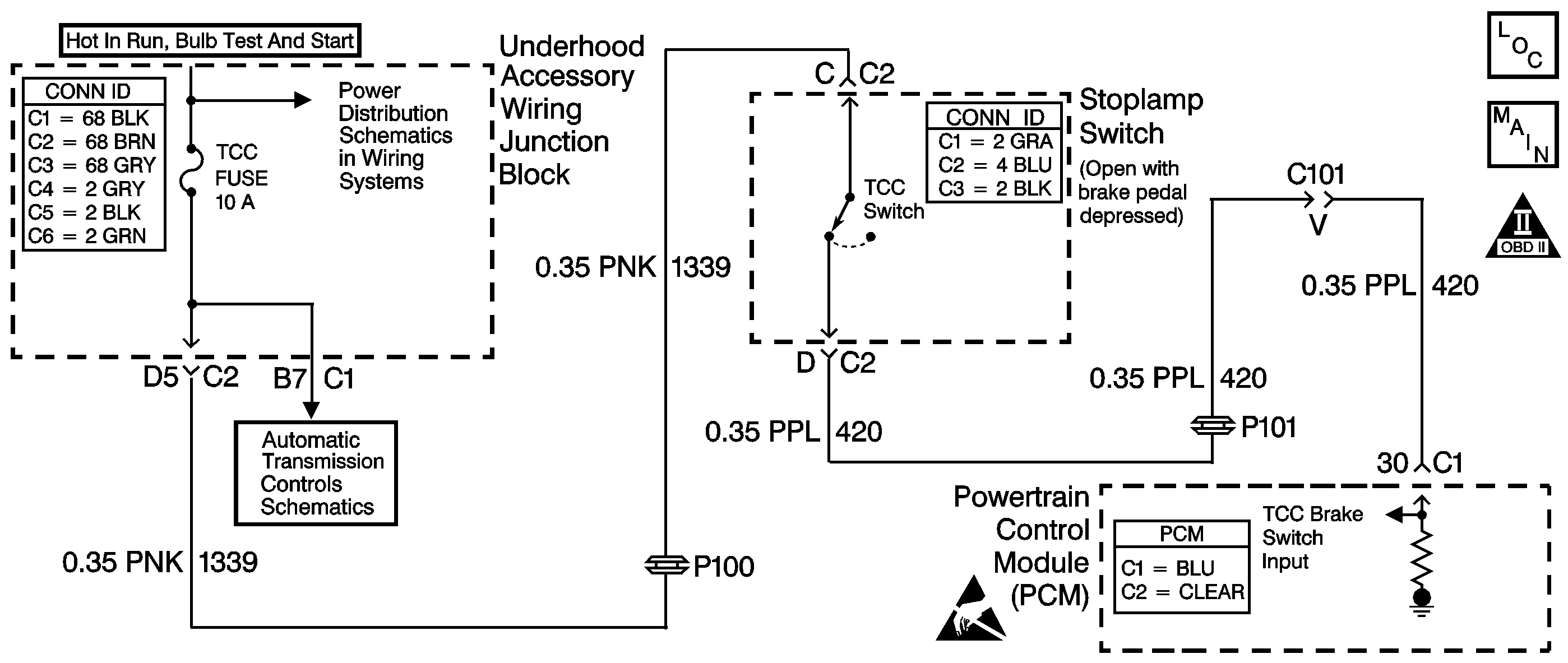
Circuit Description
The TCC brake switch indicates brake pedal status to the PCM. The TCC brake switch indicates that the brake pedal is either applied or released. The normally-closed switch supplies battery voltage to the PCM. Applying the brake pedal opens the TCC brake switch, interrupting voltage to the PCM. When the PCM receives 0 volts at the TCC brake switch input, the PCM turns OFF the torque converter clutch pulse width modulation (TCC PWM) solenoid valve.
If the PCM detects a closed TCC brake switch (indicating pedal released) during a number of decelerations, then DTC P0724 sets. DTC P0724 is a type C DTC.
Conditions for Running the DTC
No VSS DTC P0502 or P0503.
Conditions for Setting the DTC
The TCC brake switch indicates continuously CLOSED (12 volts) while the following conditions occur 8 times consecutively:
| • | The vehicle speed is greater than 32 km/h (20 mph) for 6 seconds; |
| • | Then the vehicle speed decreases to 8 km/h (5 mph) and takes 3 seconds; |
| • | Finally, the vehicle speed is less than 8 km/h (5 mph). |
Action Taken When the DTC Sets
| • | The PCM does not illuminate the malfunction indicator lamp (MIL). |
| • | The PCM records the operating conditions when the Conditions for Setting the DTC are met. The PCM stores this information as Failure Records. |
| • | The PCM stores DTC P0724 in PCM history. |
Conditions for Clearing the DTC
| • | A scan tool can clear the DTC. |
| • | The PCM clears the DTC from PCM history if the vehicle completes 40 consecutive warm-up cycles without a non-emission-related diagnostic fault occurring. |
| • | The PCM cancels the DTC default actions when the fault no longer exists and the ignition switch is OFF long enough in order to power down the PCM. |
Diagnostic Aids
| • | Inspect the connectors at the controller, the component and all other circuit connecting points for an intermittent condition. Refer to Testing for Intermittent Conditions and Poor Connections in Wiring Systems. |
| • | Inspect the circuit wiring for an intermittent condition. Refer to Testing for Electrical Intermittents in Wiring Systems. |
Test Description
The numbers below refer to the step numbers on the diagnostic table.
-
A Scan Tool display that changes from Closed to Open when the switch is disconnected indicates a faulty switch.
Step | Action | Value(s) | Yes | No |
|---|---|---|---|---|
1 | Did you perform the Powertrain Diagnostic System Check? | -- | Go to Powertrain On Board Diagnostic (OBD) System Check in Engine Controls | |
Important: Before clearing the DTCs, use the Scan Tool in order to record the Failure Records for reference. Using the Clear Info function will erase the stored Failure Records from the PCM. Does the Scan Tool display Open? | -- | Go to Diagnostic Aids | ||
3 |
Does the Scan Tool display Open? | -- | ||
4 | Test the input circuit (CKT 420) of the TCC brake switch for a short to power between the PCM and the brake switch. Refer to Circuit Testing and Wiring Repairs in Wiring Systems. Did you find and correct the condition? | -- | ||
5 | Replace the TCC brake switch. Refer to Stop Lamp Switch Replacement in Hydraulic Brakes. Did you complete the replacement? | -- | -- | |
6 | Replace the PCM. Refer to Powertrain Control Module Replacement/Programming in Engine Controls. Did you complete the replacement? | -- | -- | |
7 | Perform the following procedure in order to verify the repair:
Has the test run and passed? | -- | System OK |
